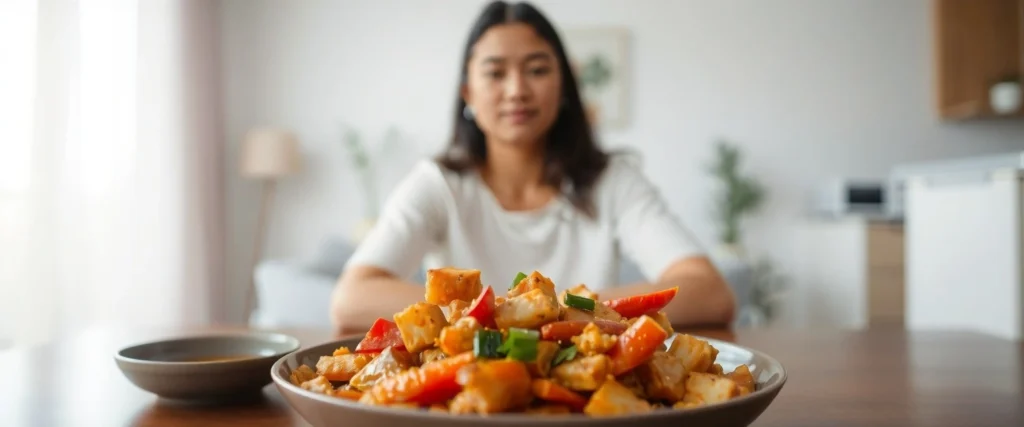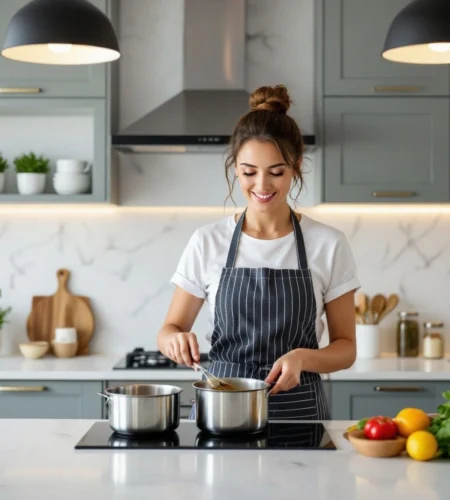When you’re cooking for one, efficiency becomes your secret weapon. Every minute saved in the kitchen is a minute gained for the things that matter to you. The beauty of solo cooking lies in your ability to optimize every aspect of your culinary routine—from the heat source you choose to the techniques that deliver maximum flavor with minimal effort.
Table of Contents
The Energy Efficiency Hierarchy
Understanding which cooking methods deliver the most bang for your energy buck transforms how you approach meal preparation. Induction cooking leads the efficiency race at 84% energy efficiency, compared to electric cooktops at 74% and gas at just 40%. This means when you cook with gas, about 60% of the energy escapes into your kitchen rather than heating your food.
Microwave cooking stands as the ultimate efficiency champion for solo portions. It focuses energy directly on your food, making it the most efficient cooking method available. For reheating leftovers, microwaves use 80% less energy than conventional ovens.
Small Appliance Advantage
When cooking for one, smaller appliances consistently outperform their full-sized counterparts. Air fryers, slow cookers, and toaster ovens can reduce energy use by up to 80% compared to conventional ovens. A typical slow cooker uses about 50-300 watts depending on size and setting, while an oven consumes 2,000-2,200 watts per hour.
Speed vs. Efficiency: The Solo Balance
High-Heat Quick Techniques
Stir-frying and sautéing represent the sweet spot for solo cooking efficiency. These methods use minimal oil while delivering maximum flavor in minimal time. The key is using oils that can withstand high temperatures—groundnut, corn, or sunflower oils work best, while olive oil should be reserved for finishing touches.

Griddling offers another fast, healthy option that uses less oil than traditional frying while creating attractive sear marks. This technique works particularly well for thin cuts of meat, seafood, and thick vegetable slices.
Pressure Cooking Revolution
Pressure cookers save up to 90% of the energy used for stovetop boiling. The sealed environment traps steam and heat, meaning cooking duration has minimal impact on total energy consumption. For solo living, this translates to perfectly tender proteins in under an hour with minimal energy waste.
Technique-Specific Efficiency Strategies
Steaming: The Gentle Giant
Steaming retains maximum nutrients while using minimal energy. Multi-tier steamers allow you to cook vegetables, fish, rice, and even meat on a single burner. This technique particularly shines for solo portions since you can prepare exactly what you need without waste.
En Papillote: Sealed Efficiency
Cooking en papillote (in parchment paper) creates a sealed environment that steams food in its own juices. This method requires no added fats and cooks food evenly while retaining moisture and nutrients—perfect for single-serving fish or vegetable portions.
Equipment Optimization for Solo Efficiency
Pan Selection Strategy
Copper-bottomed pans heat up more quickly than stainless steel, while cast-iron pans retain heat more efficiently. For solo cooking, this means faster cooking times and better heat retention for techniques like searing and braising.
Matching pan size to portion size eliminates energy waste. Using a large pan for small portions wastes energy heating unnecessary surface area. Conversely, overcrowding a small pan reduces cooking efficiency.
Lid Logic
Covering saucepans retains heat and reduces cooking time significantly. This simple technique can decrease cooking time by up to 25% while preventing moisture loss.
Advanced Efficiency Techniques
Passive Cooking
Residual heat cooking maximizes energy efficiency by turning off heat sources before cooking completes. Pasta continues cooking in hot water even after the burner is off, while casseroles finish cooking in retained oven heat during the final 10 minutes.
Batch Cooking Efficiency
Cooking larger quantities uses less energy per portion than multiple small cooking sessions. For solo living, this means preparing base ingredients in batches—roasting vegetables for the week or cooking grains in larger quantities for multiple meals.
The Solo Cooking Efficiency Matrix.csv
| Technique | Energy Efficiency | Time Efficiency | Cleanup Factor | Best For |
|---|---|---|---|---|
| Microwave | Highest | Fastest | Minimal | Reheating, small portions |
| Pressure Cooking | Very High | Fast | Low | Tough cuts, beans, grains |
| Stir-frying | High | Very Fast | Moderate | Vegetables, tender proteins |
| Steaming | High | Moderate | Low | Vegetables, fish, dumplings |
| Induction Cooking | High | Fast | Moderate | All stovetop techniques |
| Air Frying | Moderate-High | Fast | Low | Crispy textures, small portions |
| Slow Cooking | Moderate | Very Slow | Minimal | Tough cuts, hands-off cooking |
Practical Implementation for Solo Living
Daily Efficiency Habits
Pre-heating water in a kettle before adding to pans saves energy when cooking vegetables and pasta. This simple step reduces stovetop cooking time while using the kettle’s superior heating efficiency.
Defrosting frozen food in the refrigerator typically halves cooking time and eliminates the energy waste of cooking from frozen. This requires planning ahead but pays dividends in both time and energy savings.
Kitchen Setup Optimization
Keeping burners and cookware clean maintains maximum energy efficiency. Stuck-on food absorbs energy that should be heating your meal. Similarly, flat-bottomed pans ensure maximum contact with electric burners for optimal heat transfer.
The Bottom Line on Cooking Efficiency
Your solo kitchen becomes a laboratory for efficiency optimization when you understand the relationship between technique, equipment, and energy use. Induction cooking combined with appropriate pan sizes delivers maximum stovetop efficiency. Microwave cooking for reheating and small portions provides unmatched energy savings. Pressure cooking for longer-cooking items reduces both time and energy consumption dramatically.
The most efficient cooking technique is ultimately the one that matches your lifestyle, available equipment, and meal preferences. For solo living, this often means embracing smaller appliances, mastering quick-cooking techniques, and understanding how to maximize the efficiency of whatever equipment you have available.
Next steps: Evaluate your current cooking habits against these efficiency benchmarks. Start with one technique optimization—perhaps covering pans more consistently or switching to microwave reheating—and build from there. Your solo kitchen isn’t just about cooking for one; it’s about cooking smart, efficient, and exactly the way you want to live.
Use of this website constitutes acceptance of all our disclaimers and legal agreements.

